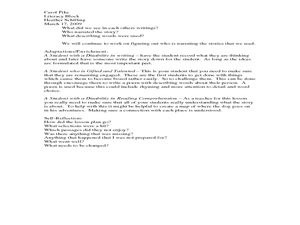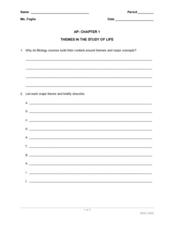Pennsylvania Department of Education
The Weight of Things
Learners explore weight. In this math lesson, students predict which item weighs more and discuss how they arrived at their decision. Learners weigh several items to determine which weighs more.
Curated OER
How Do Things Move?
In this motion learning exercise, students will use a word bank to fill in the definition of Newton's three laws of motion. Then students will complete 4 short answer questions giving examples of Newton's three laws of motion.
Curated OER
Describing Single Persons Or Things
In this grammar worksheet, students read ten sentences and then underline any incorrect singular or plural word they find used incorrectly. Students then write the word correctly.
Curated OER
Total English Upper Intermediate: Articles and Things
In this adjective articles worksheet, students practice their grammar skills as they examine 8 proofreading them for article mistakes. Students also respond to 3 short answer questions.
Curated OER
Describe and Classify 2-D Shapes
In this 2-D shapes worksheet, students match a set of descriptions to shapes given. A reference website for additional resources is given.
Curated OER
Using Words to Work Things Out
Students listen as teacher reads Words Are Not For Hurting, and answer questions about the content. Students discuss how to prevent arguments and work disagreements out with words. Students watch a puppet show that promotes discussion as...
Curated OER
To Every Thing There Is A Season...
Students use the artwork by Robert Harris to examine the four seasons. In groups, they identify the clothing worn in the artwork and create a dance which resembles the painting. They also practice reading a thermometer and identify...
Curated OER
The Most American Thing in America: The Chautauqua
Middle schoolers explore the Chautauqua movement. In this Pennsylvania history lesson, students use primary documents to explore what the Chautauqua was and how it made a difference in the American way of life.
Curated OER
Things Aren't Always What They Seem
Students use video and the Internet to make predictions, draw conclusions, determine conflict and point of view while reading a short story. For this short story analysis lesson, students watch a related video and complete a prediction...
Curated OER
Describing Our Senator
Third graders find the narrator or speaker in a story. In this story elements lesson, 3rd graders listen to the story My Senator and Me and answer comprehension questions. They complete a descriptive writing piece from different...
Curated OER
Describing Clothes and Shopping
In this clothes and shopping activity, students label clothes, rewrite sentences, fill in verbs to sentences, and more. Students complete 6 activities.
Curated OER
Taking Things Personally
High schoolers create a work of art calling attention to significant societal problems or social issues.
Curated OER
The Shape of Things
Young scholars create shape booklets. In this interdisciplinary lesson, students practice shape recognition as they participate in a scavenger hunt and create a shape booklet.
Curated OER
The Whole Thing: Learning About Complete Subjects
In this language arts worksheet, learners read information about locating the simple and complete subject of a sentence. Students locate the subject in 16 sentences.
Curated OER
Understanding to Read and Describe It
Second graders, with hearing disability, practice vocabulary building strategies. In this vocabulary strategy lesson, a student practices sight words using word cards. The student verbalizes a sentence with the new words while the...
National Park Service
Living & Non-Living Interactions
What better way to learn about ecosystems than by getting outside and observing them first hand? Accompanying a field trip to a local park or outdoor space, this series of collaborative activities engages children in...
Science Matters
Blubber Gloves: It’s All About Insulation
Instill the concept of adaptation with the help of Blubber Gloves—ziplock bags, shortening, and duct tape. Scholars discuss how animals and plants keep warm in polar regions, record their predictions, and try on their Blubber Gloves to...
Scholastic
My Favorite Activity (Grades K-2)
Scholars discuss the many ways they use persuasion in their everyday lives and brainstorm specific ideas for encouraging someone to do something. With the list of persuasive techniques they made, young writers complete a graphic...
Have Fun Teaching
Growing Seeds (9)
A seed, water, and sunlight. A seed, water, but no sunlight. A seed, sunlight, but no water. Young biologists are ask to infer what will happen to seeds given five different growing conditions.
Curated OER
Group Endeavors
Teamwork is an important thing for kids to experience early in school. Cooperative games are a great way for youngsters to enjoy working and playing together. There are two nice cooperative games described in this PE activity. Both are...
Curated OER
Frog or Toad? How Can You Tell?
Students compare and contrast frogs and toads. In groups, they research the life cycle of amphibians, their life cycles, breeding habits and ways they survive. Students list words or phrases describing their amphibian. After trading...
Curated OER
Going On An Excursion Worksheet
In this going on an excursion worksheet, students fill in the blanks describing where they went on a Saturday excursion. They tell about three things they did when they were on the trip, tell about a funny occurrence, and something they...
Curated OER
AP: Chapter 1: Themes in the Study of Life
Life science learners list and describe 10 major themes that biology courses are built around. They are introduced to the three domains and they consider the unity and diversity of living things. If your textbook does not have a chapter...
Curated OER
Greek Myths
Ever wonder why the ancient Greeks had myths? The explanation you'll find here, describes myths as stories that explain things people didn't understand. They also tell the stories of the gods people in ancient times believed in. These...























